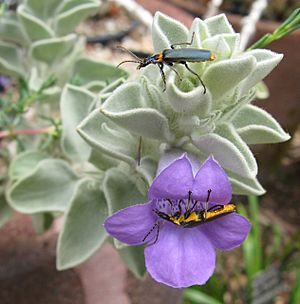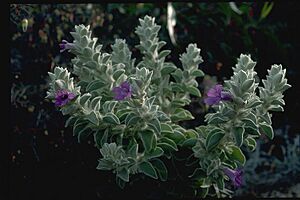Eremophila warnesii facts for kids
Quick facts for kids Eremophila warnesii |
|
|---|---|
 |
|
| Conservation status | |
| Scientific classification | |
| Genus: |
Eremophila (plant)
|
| Species: |
warnesii
|
Eremophila warnesii is a beautiful flowering plant that belongs to the figwort family. This plant is special because it grows naturally only in Western Australia. It is a neat, upright shrub with soft, furry leaves. Its flowers have fuzzy sepals and pretty blue or purple petals. This plant is not very well known, and it was named after the person who started the Eremophila Study Group.
Contents
What Eremophila warnesii Looks Like
Eremophila warnesii is a small, upright shrub. It can also spread out a bit. It usually grows to be about 30 to 50 centimeters (12 to 20 inches) tall. Its branches and leaves are covered with a thick layer of soft, white or silvery-grey hairs. Some of these hairs can be up to 5 millimeters (0.2 inches) long. The branches feel rough because of old leaf bases that stay on them.
The leaves grow one after another along the branches. They are thick and shaped like an egg. Each leaf is about 12 to 30 millimeters (0.5 to 1.2 inches) long and 10.5 to 22 millimeters (0.4 to 0.9 inches) wide. The leaves have short stems, usually 3 to 6 millimeters (0.1 to 0.2 inches) long.
The Flowers
The flowers grow one by one where the leaves meet the stem. They do not have a stalk. Each flower has 5 long, thin sepals. These sepals are 10 to 15 millimeters (0.4 to 0.6 inches) long and look a bit like claws at the tip. They are covered with thick hairs, just like the leaves.
The petals are joined together at the bottom to form a tube. The whole petal tube is 25 to 35 millimeters (1.0 to 1.4 inches) long. The petals and the ends of the tube are light purple, lilac, or blue-mauve. Inside the tube, there are pale purple spots. The outside of the flower tube and its ends are covered with many branched hairs. The inside of the ends of the petals is smooth, but the inside of the tube is very woolly. There are 4 stamens (the parts that make pollen) hidden completely inside the petal tube.
When it Flowers and Fruits
Eremophila warnesii flowers between June and October. After the flowers bloom, the plant produces fruit. These fruits are shaped like cones or flasks. They are about 6 to 7 millimeters (0.2 to 0.3 inches) long and also have a hairy covering.
How it Got its Name
This plant was officially described for the first time in 2007 by a scientist named Robert Chinnock. He published his description in a book called Eremophila and Allied Genera: A Monograph of the Plant Family Myoporaceae.
The second part of the plant's scientific name, warnesii, is a special way to honor Ken Warnes. He was the person who started the Eremophila Study Group. This group is now part of the Australian Native Plants Society (Australia).
Where Eremophila warnesii Grows
This type of eremophila plant is found in Western Australia. It grows near places like Mount Gould Station and Mount Clere Station. These areas are north-west of a town called Meekatharra. You can find it in the Gascoyne and Murchison regions. It likes to grow in open mulga woodland, which is a type of forest with many mulga trees.
Protecting Eremophila warnesii
The Western Australian Government's Department of Parks and Wildlife has given Eremophila warnesii a special classification: "Priority One". This means that the plant is only known to grow in one or a few places. Because of this, these plants could be at risk, and it's very important to protect them so they don't disappear.
Growing Eremophila warnesii in Gardens
This eremophila plant is not grown very often in gardens, but it is quite attractive. It has lovely silvery-grey leaves and large, pale lilac to purple flowers.
How to Grow It
You can grow new Eremophila warnesii plants from cuttings taken in the summer. You can also grow it by grafting it onto a Myoporum rootstock. Grafting is when you join a part of one plant to another plant's root system.
This plant grows best in soil that drains water well. It also needs a sunny spot. It can handle dry conditions (drought) and even a little bit of frost.



